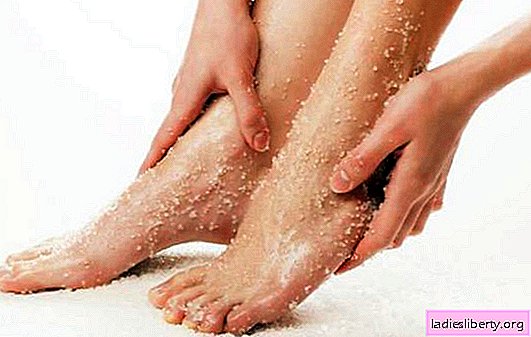
Sea salt is an excellent and affordable skin care product for the feet. The effectiveness of baths with this natural remedy has been proven for years, but what is known about the benefits and harms of sea salt?
Sea salt: description, composition
Sea salt is distributed worldwide and is used in various fields of life, for example: culinary, traditional medicine, cosmetology and industry. Such salt is usually mined from the seas. Due to this, it contains a lot more useful elements. Sea salt is not a novelty of our time, because work on its production was carried out thousands of years ago.
The composition of sea salt consists entirely of useful trace elements, minerals and macrocells. The most necessary minerals for the human body are: potassium, calcium, phosphorus, sodium. Sea salt is rich in trace elements such as: zinc, iodine, manganese, iron, bromine.
The benefits of sea salt for legs
Sea salt contains a huge list of useful mineral compounds, but what about its positive effect on the skin of the legs? The following results can be expected from the use of sea salt foot baths:
· Moisturizing the skin of the legs
· Disinfection
Anesthesia
· Elimination of a feeling of heaviness
· Prevention of leg swelling
· Elimination of sweating and unpleasant foot odor
· Prevention of fungal infections
· Strengthening the nail plate
· Prevention of seasonal diseases
If you make foot baths with the addition of sea salt, then you can avoid many problems, because this tool perfectly disinfects and anesthetizes. For example, a bath with sea salt will help relieve pain from fresh corns, disinfect the wound and speed up the healing process.
Also, baths with sea salt perfectly relieve fatigue and tension from the legs. They are recommended for use by people with a deformed foot, curvature of the spine, excess weight, because all these problems provide tremendous pressure on the foot, which causes a lot of problems and discomfort. Foot procedures with sea salt should be performed also for girls who prefer high-heeled shoes, since regular skin care for the feet with this product provides protection against corns, overstrain and edema.
Harm to sea salt for legs, and contraindications for its use
Salt foot baths, although they have great benefits, but still have a number of contraindications. Procedures with sea salt should not be performed by people who have the following factors:
Varicose veins
Diseases of the cardiovascular system
Pregnancy
Menstruation
· High blood pressure
Acute viral infections
Inflammation or skin burns
Eczema
It should be noted that the salt baths extremely dry the skin of the legs, as they are carried out in hot water. Therefore, in addition to the main ingredient - salt, it is recommended to add moisturizing ingredients or use warm water, but in this case, the procedure will be less effective.
Also, the components of the baths or the composition of the salt itself can cause an allergic reaction. If after or during the procedure, changes in the skin were noticed, then the process should be stopped immediately and an allergist should be consulted.
How to choose the most beneficial sea foot salt?
Choosing sea salt is not an easy task, as this product is popular all over the world and has hundreds of manufacturers. With the development of technologies for the production of sea salt, various chemicals, additives, dyes began to be added to it. To choose sea salt that will produce the maximum effect, you need to pay attention to the following factors:
Potassium content
The content of such a useful element as potassium in the composition of sea salt should be at least 4.20 grams, i.e. 50% of the total composition. If this indicator is less than the above, then the salt will not be as useful as its better options.
· Colour
Natural sea salt has a grayish tint. Such an inconspicuous color of salt indicates the absence of processing, which often destroys most of the useful minerals and trace elements of the product.
· Lack of chemical additives
Chemical additives in sea salt include various flavors, colorants and flavor enhancers.
Foot Salt Bath Recipes
Foot baths with sea salt is a simple and pleasant procedure that can be easily carried out at home. Let's consider several options:
Recipe number 1:
Components:
1. Sea salt
2. Eucalyptus oil
3. Hot water
It is necessary to add 4 tablespoons of sea salt and 5 drops of eucalyptus oil to hot water. The solution should be mixed and placed legs for 15-20 minutes.
Recipe number 2:
Components:
1. Sea salt
2. Baking soda
3. Hot water
It is necessary to part 3 tablespoons of soda and sea salt in hot water. Mix and place the foot in water for 15-20 minutes. The bath has an excellent disinfecting effect.
Recipe number 3:
Components:
1. Sea salt
2. Eucalyptus oil
3. Lavender oil
4. Rosemary oil
5. Hot water
In hot water, mix 2 tablespoons of eucalyptus, rosemary and lavender oils. Add sea salt to the solution and mix. The procedure should be carried out within 15-20 minutes. Such a bath will help relieve fatigue and stress.
Recipe number 4:
Components:
1. Sea salt
2. Lavender oil
3. Chamomile oil
4. Hot water
Add 3 drops of chamomile and lavender oil to hot water. Dissolve 4 tablespoons of sea salt in water. Mix the solution and immerse feet in it for 20 minutes.
Recipe number 5:
Components:
1. Sea salt
2. Hot water
Add 2-3 tablespoons to hot water. Stir and immerse in the foot solution for 15-20 minutes.
It should be noted that after each procedure, it is necessary to rinse your feet in clean water and lubricate them with a moisturizer.
How to apply sea salt for legs?
The benefit that this or that product carries in itself does not make sense if it is not used correctly. Sea salt should be used strictly in accordance with the recommendations:
1. Before the procedure, you should thoroughly wash your legs, having cleaned of contaminants with a detergent;
2. Having prepared the solution, the legs are immersed in the basin so that the water is above the ankles;
3. It should be noted that usually the bath water should be hot (approximately 38-40 degrees), but the use of contrast foot baths with alternating immersion of the feet in cold or hot water is not excluded. Pregnant women are advised to perform the procedure in warm rather than hot water, but the result will be less noticeable.
4. The duration of any foot bath with sea salt is 15-20 minutes. Do not overexpose, since hot water greatly overdries the skin.
5. After the procedure, the legs must be rinsed in clean water and greased with a rich nourishing cream.
Sea salt for legs is an excellent, quick and affordable way to relieve pain, tension, fatigue from the feet. Baths with sea salt have a broad preventive effect and are able to improve the functioning of many body systems.











